实验1现代c++编程初体验
1.实验任务一
task1.cpp
// 现代C++标准库、算法库体验 // 本例用到以下内容: // 1. 字符串string, 动态数组容器类vector、迭代器 // 2. 算法库:反转元素次序、旋转元素 // 3. 函数模板、const引用作为形参 #include <iostream> #include <string> #include <vector> #include <algorithm> using namespace std; // 声明 // 模板函数声明 template<typename T> void output(const T &c); // 普通函数声明 void test1(); void test2(); void test3(); int main() { cout << "测试1: \n"; test1(); cout << "\n测试2: \n"; test2(); cout << "\n测试3: \n"; test3(); } // 函数实现 // 输出容器对象c中的元素 template <typename T> void output(const T &c) { for(auto &i: c) cout << i << " "; cout << endl; } // 测试1 // 组合使用算法库、迭代器、string反转字符串 void test1() { string s0{"0123456789"}; cout << "s0 = " << s0 << endl; string s1{s0}; reverse(s1.begin(), s1.end()); // 反转指定迭代器区间的元素 cout << "s1 = " << s1 << endl; string s2{s0}; reverse_copy(s0.begin(), s0.end(), s2.begin()); // 将指定迭代区间的元素拷贝到指定迭代器开始的目标区间,并且在复制过程中反转次序 cout << "s2 = " << s2 << endl; } // 测试2 // 组合使用算法库、迭代器、vector反转动态数组对象vector内数据 void test2() { vector<int> v0{2, 0, 4, 9}; cout << "v0: "; output(v0); vector<int> v1{v0}; reverse(v1.begin(), v1.end()); cout << "v1: "; output(v1); vector<int> v2{v0}; reverse_copy(v0.begin(), v0.end(), v2.begin()); cout << "v2: "; output(v2); } // 测试3 // 组合使用算法库、迭代器、vector实现元素旋转移位 void test3() { vector<int> v0{0, 1, 2, 3, 4, 5, 6, 7, 8, 9}; cout << "v0: "; output(v0); vector<int> v1{v0}; rotate(v1.begin(), v1.begin()+1, v1.end()); // 旋转指定迭代器区间[v1.begin(), v1.end())之间的数据项,旋转后从迭代器v1.begin()+1位置的数据项开始 cout << "v1: "; output(v1); vector<int> v2{v0}; rotate(v2.begin(), v2.begin()+2, v2.end()); cout << "v2: "; output(v2); vector<int> v3{v0}; rotate(v3.begin(), v3.end()-1, v3.end()); cout << "v3: "; output(v3); vector<int> v4{v0}; rotate(v4.begin(), v4.end()-2, v4.end()); cout << "v4: "; output(v4); }
测试结果:
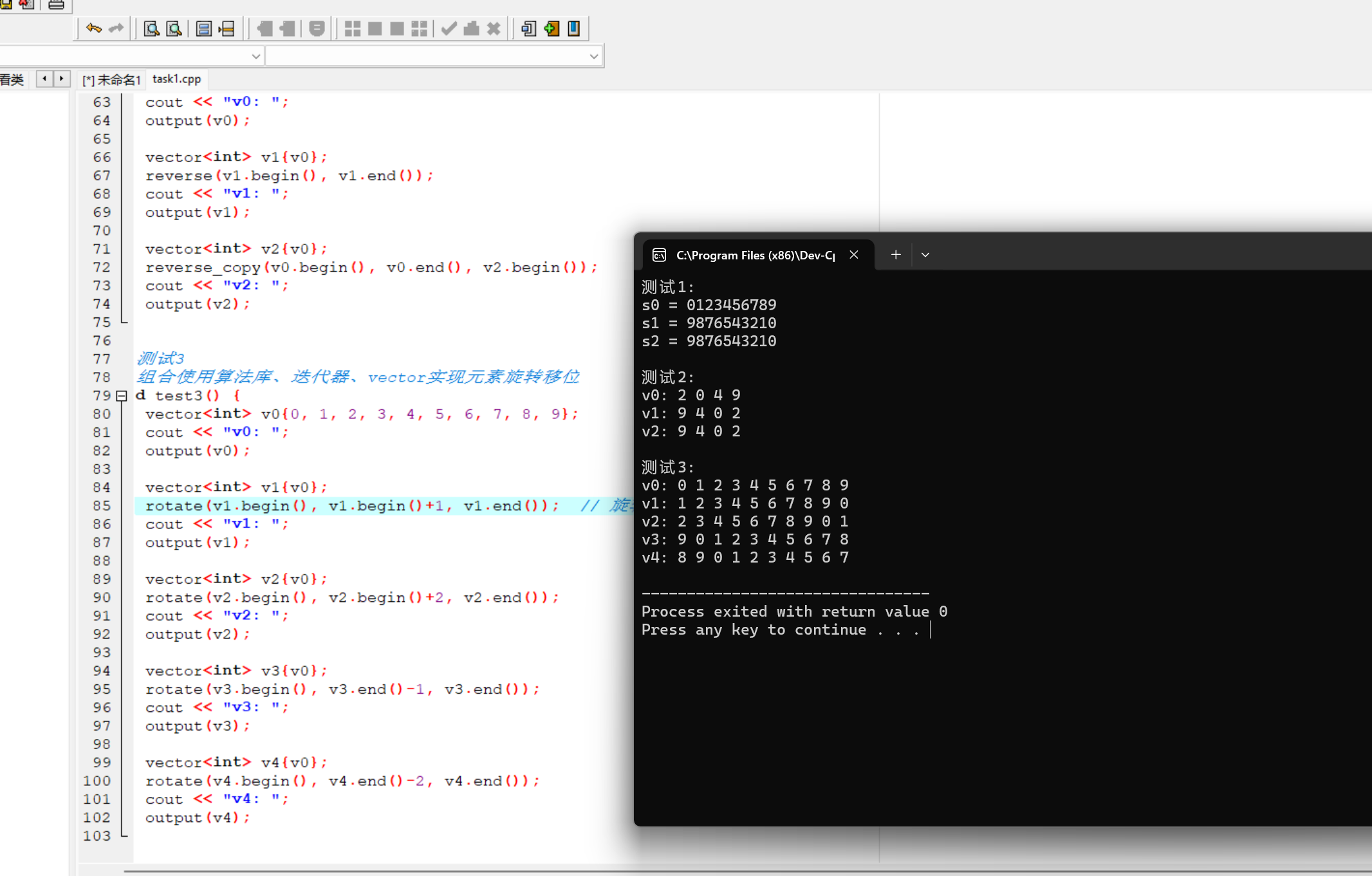
2.实验任务2
task2.cpp
#include <iostream> #include <vector> #include <string> #include <algorithm> #include <numeric> #include <iomanip> using namespace std; // 函数声明 // 模板函数声明 template<typename T> void output(const T &c); // 普通函数声明 int rand_int_100(); void test1(); void test2(); int main() { cout << "测试1: \n"; test1(); cout << "\n测试2: \n"; test2(); } // 函数实现 // 输出容器对象c中的元素 template <typename T> void output(const T &c) { for(auto &i: c) cout << i << " "; cout << endl; } // 返回[0, 100]区间内的一个随机整数 int rand_int_100() { return rand() % 101; } // 测试1 // 对容器类对象指定迭代器区间进行赋值、排序 void test1() { vector<int> v0(10); // 创建一个动态数组对象v0, 对象大小为10 generate(v0.begin(), v0.end(), rand_int_100); // 产生[0, 100]之间的随机整数赋值给指定迭代器区间[v0.begin(), v0.end())内的每个数据项 cout << "v0: "; output(v0); vector<int> v1{v0}; sort(v1.begin(), v1.end()); // 对指定迭代器区间[v1.begin(), v1.end())内数据项进行升序排序 cout << "v1: "; output(v1); vector<int> v2{v0}; sort(v2.begin()+1, v2.end()-1); // 对指定迭代器区间[v1.begin()+1, v1.end()-1)内数据项进行升序排序 cout << "v2: "; output(v2); } // 测试2 // 对容器类对象指定迭代器区间进行赋值、计算最大值/最小值/均值 void test2() { vector<int> v0(10); generate(v0.begin(), v0.end(), rand_int_100); cout << "v0: "; output(v0); auto iter1 = min_element(v0.begin(), v0.end()); cout << "最小值: " << *iter1 << endl; auto iter2 = max_element(v0.begin(), v0.end()); cout << "最大值: " << *iter2 << endl; auto ans = minmax_element(v0.begin(), v0.end()); cout << "最小值: " << *(ans.first) << endl; cout << "最大值: " << *(ans.second) << endl; double avg1 = accumulate(v0.begin(), v0.end(), 0)/v0.size(); cout << "均值: " << fixed << setprecision(2) << avg1 << endl; cout << endl; vector<int> v1{v0}; cout << "v0: "; output(v0); sort(v1.begin(), v1.end()); double avg2 = accumulate(v1.begin()+1, v1.end()-1, 0)/(v1.size()-2); cout << "去掉最大值、最小值之后,均值: " << avg2 << endl; }
测试结果:
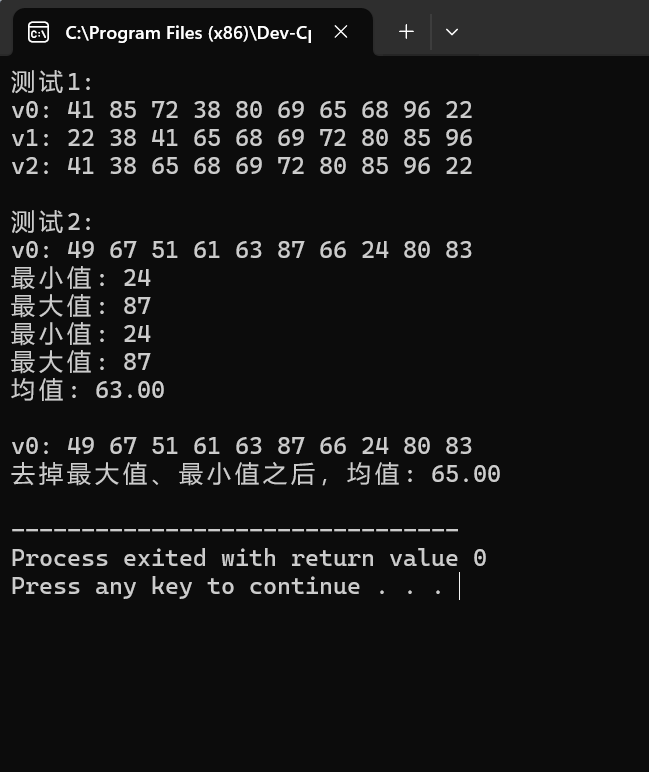
3.实验任务三
task3.cpp
#include <iostream> #include <string> #include <algorithm> bool is_palindrome(std::string s); int main() { using namespace std; string s; while(cin >> s) // 多组输入,直到按下Ctrl+Z后结束测试 cout << boolalpha << is_palindrome(s) << endl; } bool is_palindrome(std::string s) { using namespace std; string s1(s); reverse(s1.begin(),s1.end()); int cmp=s.compare(s1); if(cmp==0) return 1; else return 0; }
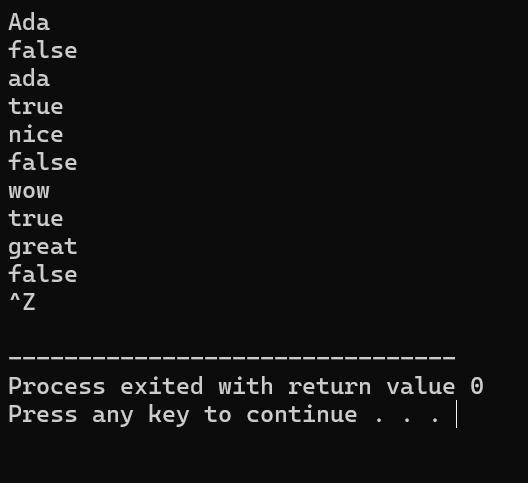
4.实验任务四
task4.cpp
#include <iostream> #include <string> #include <algorithm> std::string dec2n(int x, int n = 2); int main() { using namespace std; int x; while(cin >> x) { cout << "十进制: " << x << endl; cout << "二进制: " << dec2n(x) << endl; cout << "八进制: " << dec2n(x, 8) << endl; cout << "十六进制: " << dec2n(x, 16) << endl << endl; } } // 函数dec2n定义 std::string dec2n(int x,int n){ std::string result; if(x==0){ return "0"; } while(x>0){ int a=x%n; if(a<10){ result+=a+'0'; } else{ result+=(a-10)+'A'; } x/=n; } reverse(result.begin(),result.end()); return result; }
测试结果:

5.实验任务五
task5.cpp
#include<iostream> using namespace std; int main(){ cout<<" a b c d e f g h i j k l m n o p q r s t u v w x y z\n"; for(int i=0;i<26;i++){ cout<<i+1<<" "; for(int j=0;j<26;j++){ char letter='A'+(i+j+1)%26; cout<<letter<<" "; } cout<<endl; } return 0; }
测试结果:
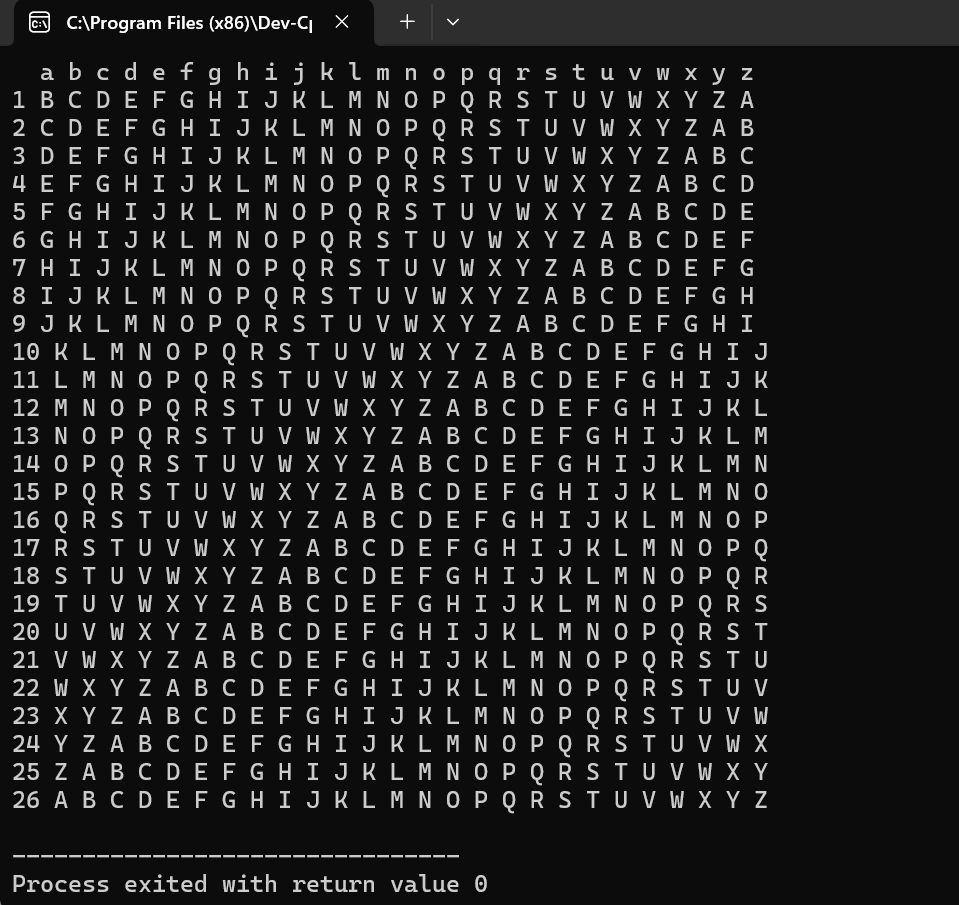
6.实验任务六
task6.cpp
#include <iostream>
#include <stdlib.h>
#include <time.h>
#include <iomanip>
using namespace std;
int test(char x,int a,int b){
if(x == '+') return a+b;
else if (x == '-') return a-b;
else if (x == '*') return a*b;
else return a/b;
}
int main()
{
char sym[4]={'+','-','*','/'};
int curr = 0;
for(int i=0;i<10;i++){
srand(time(0));
char x = sym[rand()%4];
int a,b;
if(x == '-'){
a = rand()%9+2;
b = rand()%(a-1)+1;
}
else if(x == '/'){
b = rand()%10+1;
a = b*(rand()%10/b+1);
}
else a = rand()%10+1,b=rand()%10+1;
cout<<a<<x<<b<<"=";
int ans;
cin>>ans;
if(ans == test(x,a,b)) curr++;
}
cout<<"正确率:"<<1.0*curr/10*100<<setprecision(2)<<"%";
return 0;
}
测试结果:
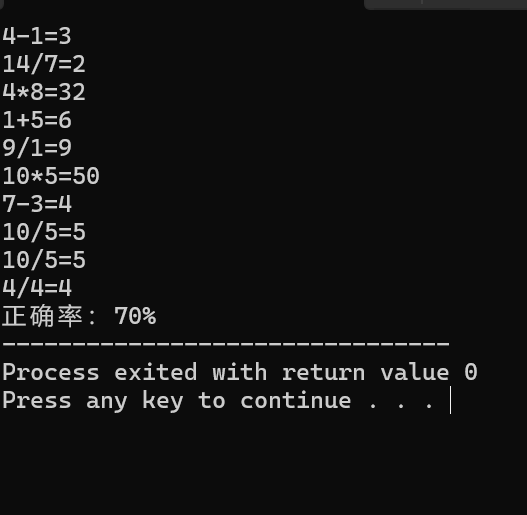
7.实验总结
通过本次实验,我了解了动态数组容器类vector,迭代器等的运用;通过实验一实验二初步了解了反转元素次序和旋转元素
- reverse(s1.begin(), s1.end()); // 反转指定迭代器区间的元素
- reverse_copy(s0.begin(), s0.end(), s2.begin()); // 将指定迭代区间的元素拷贝 到指定迭代器开始的目标区间,并且在复制过程中反转次序
- 通过实验3实践了以上内容
通过自己动手编写了实验任务4.5.6,让我对C++有了更深一步的理解和使用。





【推荐】国内首个AI IDE,深度理解中文开发场景,立即下载体验Trae
【推荐】编程新体验,更懂你的AI,立即体验豆包MarsCode编程助手
【推荐】抖音旗下AI助手豆包,你的智能百科全书,全免费不限次数
【推荐】轻量又高性能的 SSH 工具 IShell:AI 加持,快人一步
· 被坑几百块钱后,我竟然真的恢复了删除的微信聊天记录!
· 【自荐】一款简洁、开源的在线白板工具 Drawnix
· 没有Manus邀请码?试试免邀请码的MGX或者开源的OpenManus吧
· 园子的第一款AI主题卫衣上架——"HELLO! HOW CAN I ASSIST YOU TODAY
· 无需6万激活码!GitHub神秘组织3小时极速复刻Manus,手把手教你使用OpenManus搭建本